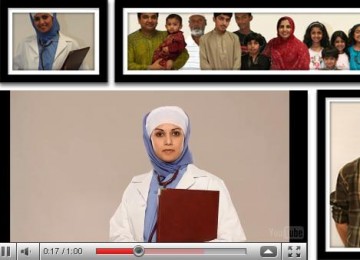Boomerang Effects in the Muslim-American Advertising Campaigns

The efforts by Feisel Abdul Rauf and allies to tell their side of the story in the debate over the Islamic cultural center in lower Manhattan are not intended to change the minds of committed opponents but rather to engage the majority of Americans who still remain relatively inattentive and ambivalent about the controversy. As researchers note, one key to engaging ambivalent audiences on the debate–and on Islam more generally–is to counter the impression that Muslim-Americans are the “Other.”
With this strategy in mind, the Council on American-Islamic Relations (CAIR) and a grassroots group called My Faith, My Voice have launched a series of online public service videos that have gained a significant amount of free media attention via news coverage and blogs.
The CAIR ads featuring the frame of reference “9/11 Happened to Us All,” include Muslim-American first responders from New York who discuss how they were impacted by the attacks and the co-workers that they lost. “We felt it was really important to do something that would humanize Muslims to our fellow Americans and then also remind everybody that on 9/11 Al-Qaeda attacked the United States, not Islam,” CAIR’s Corey Sailor told WNYC’s On the Media last week. “And while Al-Qaeda was murdering Americans, they also murdered 32 Muslims, and among those responding to the attacks were a number of Muslims. So we wanted to feature those stories.”
The My Faith, My Voice campaign features a diversity of Muslim-Americans discussing their shared values as Americans pursuing life, liberty, and happiness. Of note, all of the adult women in the ads wear head scarves.
The two ad campaigns underscore the challenge and complexity of developing messages that effectively engage audiences and influence perceptions. At one level the strategy to emphasize shared common experiences and values is the correct choice, designed to erode the perception of Muslim-Americans as the “Other.”
But by emphasizing 9/11 and by featuring Muslim women in headscarves, the ad campaigns might have what communication researchers call a “boomerang effect,” triggering the opposite reaction than intended. The 9/11 attacks and the Muslim head scarf, for a substantial proportion of Americans, are ingrained in memory as powerful mental schematics and associated with negative emotions and stereotypes.
As a result, despite the ads’ intentions and the stories told by the featured Muslim-Americans, for many audience members quickly viewing the ads, the 9/11 frame of reference and the visual of the head scarf are likely to serve as negative mental short cuts.
So in sum, the general strategy of the ads to breakdown the perceived “otherness” of Muslim-Americans is sound and correct. But given the likelihood of a boomerang effect with any ad campaign, the CAIR ads would have been better off avoiding the 9/11 frame of reference. Similarly, the Our Faith, Our Voices ads would have been on safer ground if they had featured the many Muslim-American women who choose not to wear headscarves [as a second CAIR ad does.]
You can listen to the On the Media interview with CAIR’s Corey Sailor below and then watch the first of the CAIR ads followed by the My Faith, My Voice PSA.
What do readers think? Are these ads likely to be effective? Do you agree that the ad campaigns risk a boomerang effect by evoking 9/11 and by featuring Muslim-American women in headscarves?





